What is a wildfire?
A wildfire also known as a wildland fire, forest fire, vegetation fire, grass fire, peat fire, bushfire (in Australia), or hill fire is an uncontrolled fire often occurring in wildland areas, but which can also consume houses or agricultural resources. Wildfires often begin unnoticed, but they spread quickly igniting brush, trees and homes.
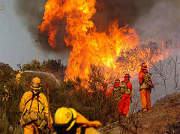
What causes a wildfire?
Common causes of wildfires include lightning, human carelessness, arson, volcano eruption, and pyroclastic cloud from active volcano. Heat waves, droughts, and cyclical climate changes such as El Niño can also have a dramatic effect on the risk of wildfires. Although, more than four out of every five wildfires are caused by people.
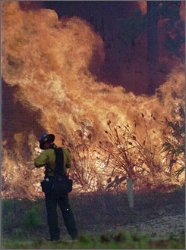
Where can wildfires occur?
Wildfires can occur anywhere, but are common in the forested areas of the United States and Canada. They are also susceptible in many places around the world, including much of the vegetated areas of Australia as well as in the Western Cape of South Africa. The climates are sufficiently moist to allow the growth of trees, but feature extended dry, hot periods. Fires are particularly prevalent in the summer and fall, and during droughts when fallen branches, leaves, and other material can dry out and become highly flammable. Wildfires are also common in grasslands and scrublands.
What are the Santa Ana winds?
The Santa Ana winds are hot, dry winds that aggravate the fire danger in forests and bush lands. These winds characteristically appear in Southern California and Northern Baja California weather during autumn and early winter. In southern California, under the influence of Santa Ana winds, wildfires can move at tremendous speeds, up to 40 miles in a single day, consuming up to 1,000 acres per hour. Dense clouds of burning embers push ahead of the flames crossing firebreaks without a problem.
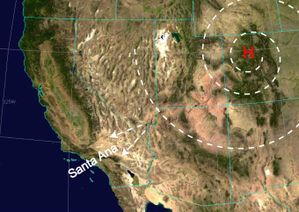
What is a fire tornado?
A fire tornado or fire whirl is just a tornado made of fire. It happens when certain conditions (depending on air temperature and currents), acquires a vertical vorticity and forms a whirl, or a tornado-like effect. Fire tornadoes may be whirlwinds separated from the flames, either within the burn area or outside it. A fire tornado can make fires more dangerous.
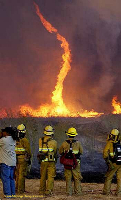
How do firefighters put out the wildfires?
Firefighters use a tool known as a pulaski. Its a combination of an ax and hoe used to dig a fireline. A fireline is a strip of land from which all brush and debris have been cleared to rob a wildfire of its fuel. Firefighters also use hotshots and smoke jumpers to clear a large path in a big circle around the fire so the blaze is contained in a ring of dirt. When the fire reaches this area, it runs out of fuel and starves to death. If the fire is too large, however, planes and helicopters fly overhead, dropping water and special chemicals that smother the flames. This pink, fire-retardant chemical is called sky jell-o.
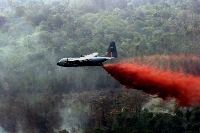
Click Here to get the latest wildfire information.
Click Here for to get more wildfire information.
Click Here to see if there has been any recent wildfire activity across the U.S.
SURFACE FIRES - The most common type of wildfires, surface fires move slowly and burn along the forest floor, killing and damaging vegetation.
GROUND FIRES - These are usually started by lightning, ground fires burn on or below the forest floor through the root system.
CROWN FIRES - These fires spread by wind moving quickly along the tops of trees.
SANTA ANA WINDS - "Santa Ana" is the name given to the gusty northeast or east wind that occurs in Southern California during the fall and winter months. Santa Ana winds are often hot and very dry, greatly aggravating the fire danger in forests and bush lands.
CONFLAGRATION - A large and destructive fire, typically aggravated by strong winds that carry firebrands over natural or artificial barriers.
Click Here to learn about more wildfire facts!
BEFORE A WILDFIRE: Have a disaster plan. Know whether you’re in a wildfire prone area. Plant fire resistant shrubs and trees around your home. Have a garden hose that is long enough to reach around your home. Prepare a disaster supplies kit for your home and car. Include a first aid kit, canned food and a can opener, bottled water, battery-operated radio, flashlight, protective clothing and written instructions on how to turn off electricity, gas, and water. Always listen to the radio and television for the latest information and instructions for your area.
DURING A WILDFIRE: If you’re advised to evacuate then do so immediately. Wear protective clothing and lock your home. Tell someone you left and where you are going. Choose a safe route away from fire hazards. Watch for changes in the speed and direction of fire and smoke.
AFTER A WILDFIRE: Stay away from wildfire areas until it is safe.
Lesson Plan: Here is a great lesson plan on teaching students to have an escape plan if a fire threatens their home.
Science Fair Project Ideas: Here is a complete list of science fair project ideas. Discover the science behind the weather that impacts us every day.